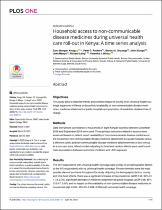| dc.contributor.author | Kiragu, Zana Wangari | |
| dc.contributor.author | Rockers, Peter C. | |
| dc.contributor.author | Laing, Richard | |
| dc.date.accessioned | 2022-10-06T07:49:48Z | |
| dc.date.available | 2022-10-06T07:49:48Z | |
| dc.date.issued | 2022 | |
| dc.identifier.citation | Kiragu, Z. W. et al. (2022). Household access to non-communicable disease medicines during universal health care roll-out in Kenya: A time series analysis. PLoS ONE, 17(4), e0266715. 10.1371/journal.pone.0266715 | en_US |
| dc.identifier.issn | 1932-6203 | |
| dc.identifier.uri | 10.1371/journal.pone.0266715 | |
| dc.identifier.uri | http://hdl.handle.net/10566/8023 | |
| dc.description.abstract | This study aims to describe trends and estimate impact of county-level universal health coverage
expansion in Kenya on household availability of non-communicable disease medicines,
medicine obtainment at public hospitals and proportion of medicines obtained free of
charge. Data from phone surveillance of households in eight Kenyan counties between December
2016 and September 2019 were used. Three primary outcomes related to access were
assessed based on patient report: availability of non-communicable disease medicines at
the household; non-communicable disease medicine obtainment at a public hospital versus
a different outlet; and non-communicable disease medicine obtainment free of cost versus
at a non-zero price. Mixed models adjusting for fixed and random effects were used to estimate
associations between outcomes of interest and UHC exposure. | en_US |
| dc.language.iso | en | en_US |
| dc.publisher | Public Library of Science | en_US |
| dc.subject | Public health | en_US |
| dc.subject | Diabetes | en_US |
| dc.subject | Heart disease | en_US |
| dc.subject | Kenya | en_US |
| dc.subject | World Health Organization (WHO) | en_US |
| dc.title | Household access to non-communicable disease medicines during universal health care roll-out in Kenya: A time series analysis | en_US |
| dc.type | Article | en_US |

